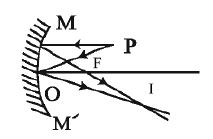When light reflected from an object comes directly to our eyes, we see the object then. Again, if light does not enter our eyes directly rather it comes to our eyes being reflected or refracted in another medium, then also we see the object. Then it seems that the object is not in its actual position. When you see your image in a mirror, then it appears to you that you are behind the mirror. Actually you are in front of the mirror. The reflection of an object seen at the new position due to the presence of the mirror is called the image of that object.

Fig(1)
In figure (1), O is a point object in front of a concave mirror. The ray OM from the point 0 being parallel to the principal axis incident on the mirror and reflected through the principal focus along the line MFI. The ray OP incident on the pole P reflects along the path PI. The reflected rays intersects at the point I. The point I is the image of the point 0.

Fig (2)
In figure (2), O is a point object in front of a plane mirror. From the point 0, the ray OT incident perpendicularly on the mirror and reflects along the path TO. The ray OQ incident obliquely on the mirror and reflects along QR. As these two rays are diverging, if they are extended backward they meet at the point I. Therefore, the reflected rays seem to be diverging from the point I behind the mirror. This point I is the image of the point O.
If a beam of rays after being reflected from or refracted through any surface meet at a second point or appears to diverge from the second point, then the second point is called the image of the first point. An object is the sum of innumerable points. As a result, image of an object is formed as like as an individual point.









